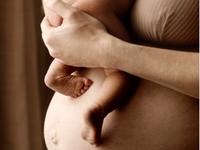The vast disparities in maternal healthcare in the United States are often referred to as a “gap.” But what they really amount to is a crisis: a shameful failure at the expense of millions of mothers (and babies) who are negatively impacted by a lack of access to essential reproductive care. 80 percent of maternal deaths are preventable—yet in the US, the maternal health crisis has only worsened in recent years. Even as one of the wealthiest countries on the planet, the US ranks 55th in the world for maternal mortality, according to a 2020 WHO report—the worst of any developed nation.1,2
So where do we go from here? Let’s start by breaking down some of the realities of the maternal health crisis—and how to take meaningful action.
Maternal mortality is defined as the death of a woman due to obstetric-related circumstances, during pregnancy or within one year of the end of the pregnancy.
Maternity care access is defined as access to maternity resources, obstetric providers, birth centers, or hospitals offering obstetric care.
Maternal death rates doubled from 1999 to 2019—and they’re getting worse.
In 2021, the maternal mortality rate was 32.9 deaths per 100,000 live births, compared with a rate of 23.8 in 2020 and 20.1 in 2019. That’s a total of 1,205 women who died of maternal causes in 2021. 2
Black women are dying at a rate nearly 3x higher than white women.
There are alarming racial disparities in maternal health—for American Indian and Alaskan Native (AIAN) women, the rate is about 2x the rate of non-Hispanic white women. Experts trace these gaps to a number of factors, including maternity care access, racial bias, and a lack of resources in the crucial months after birth. Some promising data has shown that when pregnant women have access to doulas, their health outcomes trend better.2
36% of counties in the US are considered “maternity care deserts.”
That’s 5.6 million women (and 350,000 babies) who lack access to maternity care services like an OB/GYN or obstetric services at a hospital. And there’s actually been an increase in maternity care deserts over the past few years.3
32 million women lack access to crucial reproductive care.
That’s a staggering number of reproductive-age women who are now more vulnerable to poor health outcomes.3
How to take action
Addressing the maternal health crisis will take all of us. It means getting loud on behalf of women who might not have the opportunity to do so—and directing resources towards experts and advocate groups who are enacting real change.
Spread knowledge.
In order to fuel change, we have to spread awareness about how dire these circumstances are—and make it clear that the maternal health crisis is something that can no longer be ignored. Share the facts and tough statistics so more members of your community might be inspired to take action.
Donate to organizations that are tackling the crisis head-on.
One of the best ways to take action is to amplify the work of experts and activists who are driving meaningful change. If you are able, consider donating to an organization like Black Mamas Matter Alliance (the org behind Black Maternal Health Week, which is now federally recognized)—or Birth Queen, a nonprofit dedicated to empowering, supporting and educating Black moms and birthing people (founded by doula and Perelel panelist Rachel Nicks).
Lobby your lawmakers.
Advocate in your own community to support Black Maternal Health and contact your Senator to support bills like the latest proposed Black Maternal Health Momnibus Act. This act builds on existing legislation like 12-month postpartum Medicaid coverage to comprehensively address every dimension of the maternal health crisis in the United States. Highlights of legislation include, but are not limited to:
- Provide funding to community-based organizations that are working to improve maternal health outcomes and promote equity.
- Promote innovative payment models to incentivize high-quality maternity care and continuity of insurance coverage from pregnancy through labor and delivery and up to 1 year postpartum.
- Grow and diversify the perinatal workforce to ensure that every mom in America receives culturally congruent maternity care and support.
- Make critical investments in social determinants of health that influence maternal health outcomes, like housing, transportation, and nutrition.
Let’s create a world with more healthy, supported women—together.
At Perelel, we believe that everyone has the right to a healthful pregnancy. That’s why we’re committed to addressing disparities in women’s healthcare and connecting underserved women with essential prenatal support. For every subscription to our Motherhood Suite, we donate a supply of vitamins to a woman who lacks access to quality prenatal care.
This article is for informational purposes only. It is not, nor is it intended to be, a substitute for professional medical advice, diagnosis, or treatment and we recommend that you always consult with your healthcare provider. To the extent that this article features the advice of physicians or medical practitioners, the views expressed are the views of the cited expert and do not necessarily represent the views of Perelel.
Resources:
- Trends in Maternal Mortality. WHO, UNICEF, UNFPA, World Bank Group and the United Nations Population Division
- Petersen, E. E., Davis, N. L., Goodman, D., Cox, S., Syverson, C., Seed, K., Shapiro-Mendoza, C., Callaghan, W. M., & Barfield, W. (2019). Racial/ethnic disparities in pregnancy-related deaths — United States, 2007–2016. MMWR. Morbidity and Mortality Weekly Report, 68(35), 762–765.
- New March of Dimes research shows access to maternity care worsening for millions of women in the U.S. March of Dimes.




















